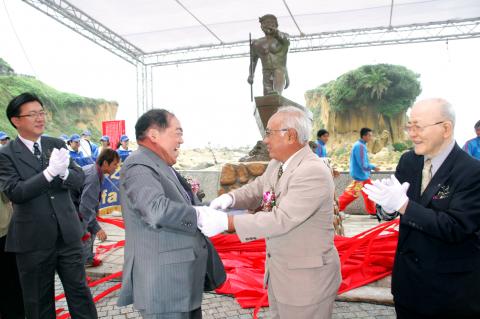|
Statue honors
Okinawans who died in 228 Incident
REMEMBRANCE: The statue of an Okinawan fisherman
memorializes those who died in the 228 Incident. Between 1905 and 1945, up to
500 of them lived on Heping Island
By Loa Iok-sin / Staff Reporter

Keelung mayor Chang Tong-rong,
center left, and Japan's Miyakojima mayor Toshihiko Shimoji, center right, shake
hand after unveiling a statue to commemorate Okinawa fishers who died during the
228 Incident in 1947 during a ceremony in Keelung yesterday.
Photo: Loa Iok-sin, Taipei Times
Braving strong winds, rain and waves
pounding the shore, officials and residents from Keelung and Japan’s Okinawa
Prefecture yesterday jointly unveiled a statue of an Okinawan fisherman with
cheers, music and words of friendship to commemorate Okinawans who died during
the 228 Incident.
The ceremony started with a Buddhist rite, hosted by the head monk from Seikoji
Temple in Okinawa, at Wanshantang — a small temple with urns containing bones
and ashes of people of unknown identity or those who died without descendants —
near the monument on Keelung’s Heping Island (和平島), which is just off Taiwan
proper.
Bodies of Okinawan fishermen, including more than 30 of them who were killed by
Chinese Nationalist Party (KMT) troops in the 228 Incident, were buried at
Wanshantang.
The 228 Incident refers to the large-scale uprising across the island in 1947
against the KMT regime, which was put down in a violent crackdown.
“We’ve always heard that some of our ancestors are here in Keelung and the
people of the city have always remembered them in religious rites,” the monk
said. “We’re holding a religious rite and have erected a monument here to
comfort the spirits of our ancestors.”
“Meanwhile, we would also like to express our gratitude to the people of Keelung,”
the monk added.
Chou Chen-tsai (周振才), a board member of the 228 Care Association, said that from
about 1905 to the end of World War II, as many as 500 fishermen from Okinawa,
whose former name was Ryukyu, had settled on Heping Island, forming a “Ryukyu
village” there, and lived side by side with Taiwanese.
Many Okinawan fishermen stayed after the end of the war and some were killed
during the massacre in 1947.
“That there were Okinawan victims of the 228 Incident are not known among the
public, but we’ve always heard about it from locals. So, around eight years ago,
organizations of the 228 Incident and historians launched a research project in
both Taiwan and Okinawa and have confirmed it as fact,” Chou said.
“That’s why we’re erecting a monument here, not only to remember the deceased,
but also to remind the public about the forgotten history,” Chou added.
The religious rite was followed by a ceremony to unveil the monument by Keelung
Mayor Chang Tong-rong (張通榮) and Toshihiko Simoji, mayor of Miyakojima City in
Okinawa Prefecture, where many of the Okinawan fishermen who settled on Heping
Island came from.
The mayors thanked each other for their help in erecting the statue and
expressed the hope that the monument would help to enhance exchanges between the
two cities, which were quite frequent before 1945.
Many Okinawans whose ancestors had once lived on Heping Island also attended the
ceremony — among them was Shiosei Yashumoto, whose great-uncle, Chouzou Uchima,
lived on Heping Island from 1905 to 1945, and was the model for the fisherman
statue.
“My great uncle lived in Taiwan from 1905 to 1945. He was a good friend of
Taiwanese, he taught them some fishing techniques unique to Okinawa and gave his
Taiwanese friends fish during wartime when the [Japanese colonial] government
prohibited selling fish to the Taiwanese,” Yashumoto said through a translator.
“He was even arrested for that, but he was released by arguing that he didn’t
‘sell’ the fish, rather, people took it from him for free.”
|
![]()
![]()
![]()